Along with your freediving mask, a good wetsuit is a very important piece of equipment in freediving. All too often I see students attracted by the lure of carbon fins or a fancy diving watch, only to have no budget left for a good wetsuit. This is the worst decision you can make as a beginner freediver, and any experienced freediver will tell you so.
This is especially true for cold water freediving or spearfishing, where a good quality, custom fit, high quality neoprene wetsuit makes all the difference.
As a reference for our international community, when I mean cold, I mean outside temperatures of 0-10°C (30 – 50°F) and water temperatures of 4-8°C (35 – 45°F).
Read below to find out what key things you should look for when getting a new wetsuit.
In this article we’ll answer questions such as:
- Should I get a lined wetsuit or unlined wetsuit?
- What is the best neoprene?
- Shoud I get a custom fit or stock sizing?
- What thickness of wetsuit do I need?
- Should I get a long John or high waist bottoms?
- Do I need to poke holes in the hood for equalization?
Should I get a custom fit or stock sizing?
This is the big question people ask themselves at the “checkout”. Should I pay extra for a custom fit suit?
If you’re an experienced freediver or a competition diver you know you want a custom, regardless of where you’ll be diving. And if you’re just getting started in the sport, here’s what you need to know:
- If you’re starting off freediving in warm water or you’ll be training exclusively in the pool, then a custom sizing fit is not as important. Buy a wetsuit that fits accordingly (most manufacturers provide a sizing chart) to your body type. Try out several models and sizes if you can. Like any other sport, you’ll figure out what you’ll like or don’t like, and in time adjust your preferences as you improve. If you can afford the extra cost of a custom fit, you’ll feel more comfortable and the suit will likely last you longer.
- If you’re a beginner to freediving in cold water (i.e. 5°C to 20°C or less), then you should get a custom tailored fit. It is well worth it, believe me. Why? The first line of defense against the cold is reducing the flow of water against your skin. When a wetsuit is fitted snug to your body, there will be minimal flow of water, which will allow you to maintain a constant body temperature for longer. Of course this depends on the temperature gradient of your body, the wetsuit thickness and the outside water temperature (some more info here).
What are some signs that your wetsuit doesn’t fit too well?
- There’s several folds of the neoprene around the chest, neck, armpits and back. If you can grab (gently) or pinch these and there’s plenty of space beneath then it’s likely too large and will flush with water.
- It’s constantly flushing as you duck dive or move at depth. If you keep noticing a chilling flush of cold water down your back or elsewhere, then yes, there’s an issue.
- If it’s uncomfortable around the chest area, or neck then it could be too tight. This is also very bad since it can restrict breathing and motion.
- A very tight wetsuit can increase the likelihood of a barotrauma or a “squeeze”. I’ve experienced this personally and know other instructors that have as well. For a while I dove with a wetsuit that was very warm, but all too tight around the chest and neck. This caused even more discomfort at depth (compression of the neoprene) and resulted in minor trachea squeezes that otherwise never occurred before.
What is the best neoprene?
The common type of neoprene used in freediving comes (mostly) from Japan and is made from limestone. There are several manufacturers of neoprene such as Yamamoto (example: Oceaner wetsuits), Heiwa (example: Azure wetsuits), NJN and Sheico. These manufacturers use a closed-cell foam design that allows for a light weight, compressible, flexible neoprene with high heat retention.
Among these types of neoprenes, the most common for high-end suits are Yamamoto (more common in North America) and Heiwa (more common in Europe). Both manufacturers create neoprenes with very good flexibility, comfort, and strength. Naturally these are all characteristics you want in your wetsuit.
The biggest issue with cheaper freediving wetsuits and neoprene is compressibility. Neoprene for freediving suits consist of >80% gas, and this gas compresses at depth. Some neoprene can compress and decompress thousands of times. Other neoprenes compress only a few times. A cheap 3-mm suit can decrease in thickness by more than 1 mm (over 30% decrease!) after a few diving sessions. A good neoprene will remain flexible and warm for a long time if properly cared for (see here for care and maintenance).
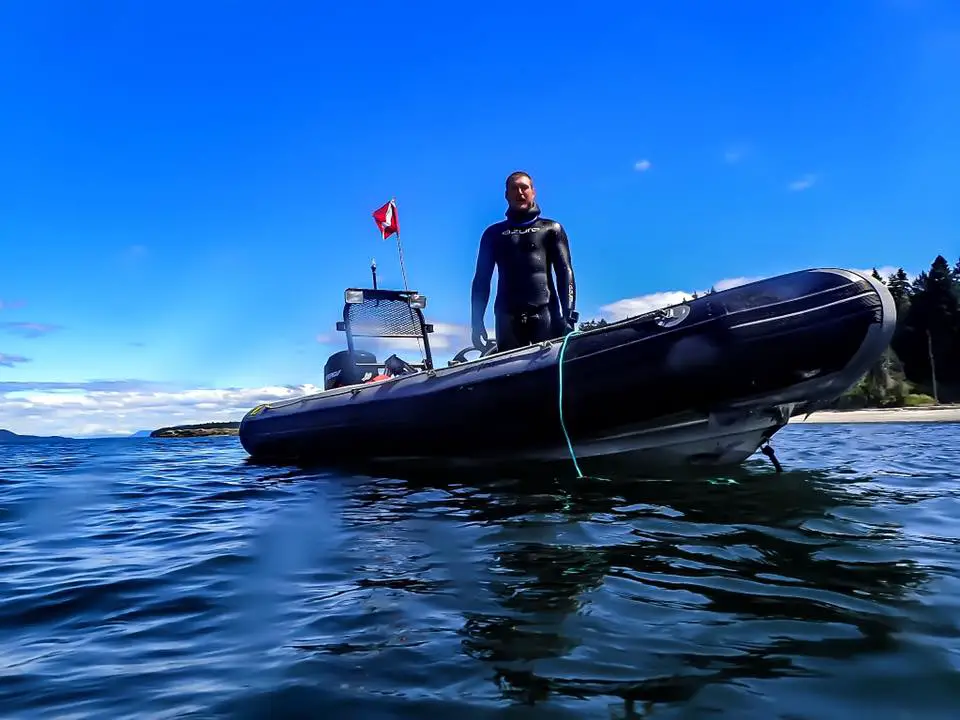
Most manufacturers of freediving suits will let you know what type of neoprene they use in their suits. If they don’t, keep shopping.
- If you’re a beginner diving in warm water or training in the pool, you may not need a top-of-the-line suit to start off with. You will be wearing a thin wetsuit, for which the type of neoprene won’t make as much a difference in the comfort and flexibility during your dives. However, if you have the budget, see it as a long term investment (that’s what I tell myself with every wetsuit I buy).
- If you’re a beginner diver in cold water that is a different story. You will have to wear a thicker wetsuit (anywhere from 5mm to 8mm) to stay warm, and thus having a neoprene which is custom fitted, flexible and comfortable will make a huge difference. However, ensure you get a lined neoprene (see section below) and learn how to properly put on and remove the wetsuit.
To conclude, cold water freediving in itself is far different than freediving in the tropics. Having a higher quality of neoprene will go a long way in keeping you both warm, comfortable, but also safe.
Should I buy a lined or unlined freediving wetsuit?
If you’re a beginner freediver, get a wetsuit with an outer lining. An unlined wetsuit (both inside and out) is very easily torn or ripped, and we don’t recommend it for beginner freedivers. Additionally, you can use a lined suit for spearfishing and diving around rocks and sea lions without having to worry about it getting torn to shreds.
But what is lined or unlined? So, what’s open cell or closed cell?
There is a lot of confusion around the term ‘open cell’. Open cell foam is foam with an interconnected network of cells (think the kitchen sponge). Closed cell foam has cells that are not interconnected (neoprene). However, in our terminology we abuse the term open cell to talk about any unlined side of neoprene. Anything called an ‘open cell’ freediving suit usually means a suit without a lining on the inside. Usually we prefer unlined on the inside, and lined on the outside. A lining can be of fabric or smoothskin (a smooth lining made of neoprene or rubber that does not absorb water and is slightly stronger and creates less drag than unlined neoprene).
If you plan on spearfishing you want the outside of the wetsuit lined with either lycra or nylon. These linings will protect your neoprene wetsuit since the linings have a good resistance to abrasion. Lycra (known as spandex) tends to be more flexible than nylon, but less resistant, whereas nylon is better with abrasion, but at a cost to flexibility. This also depends on the thickness of the lining, subject to different manufacturer’s designs. Some manufacturer’s have “super stretch nylon”, which is a combination of both characteristics.
Unlined, or “smooth skin” provides a far more comfortable fit then any lining available, however, at the cost of durability and strength. A smooth skin wetsuit is far more susceptible to tearing or ripping. Smooth skin wetsuits are excellent for competitions because of the low drag they create and because they don’t absorb any water.
Remember, an unlined (inside) wetsuit must be properly lubricated on the inside before putting it on.
Once again, if you’re an experienced freediver you might even be able to spear for Lionfish with a smooth skin wetsuit and get away minimal scratches.
- If you’re a beginner freediver in warm water or mostly di pool training, you should have a lining on the outside, lycra or nylon. Your wetsuit can easily snag on the pool edge or on a coral. Since you’re in warm water you can also have a lining on the inside, which will sacrifice some comfort unlike the unlined, but it will be easier and faster to put on or take off since you will not need any lubricant. However, if you want a real nice snug fit with greater comfort, then having unlined smooth skin on the inside is the way to go.
- If you’re a beginner freediver in cold water, you should still have a lining on the outside, either lycra or nylon. You should not have a lining on the inside. However, remember that the inside is still prone to scratches and tears, so proper care must be used when putting on and taking off the wetsuit.
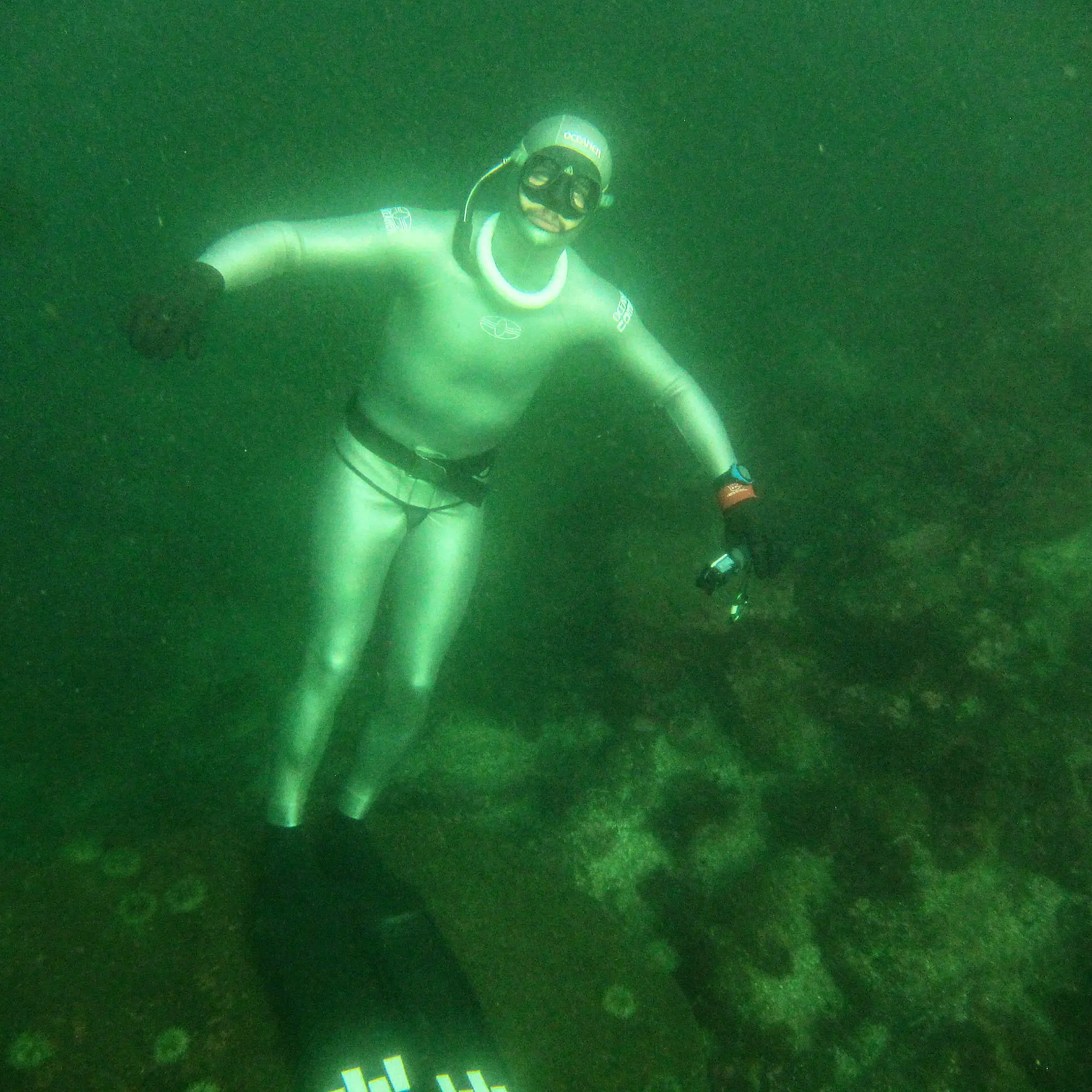
Other important details about freediving wetsuits
- Most wetsuit manufacturers offer a “high waist” or a “Long John” design for the bottom part of the wetsuit. The high waist goes up to just above the belly button, and is suitable for almost all type of diving, especially warm water diving. It’s by far the most comfortable since there’s no restrictions on the chest (except for your top) and covers the belly, keeping you warm. The “Long John” bottoms option covers the chest and leaves the arms exposed. This restrains movement and compresses the chest slightly, however it adds a layer of neoprene on the chest and keeps you far warmer in frigid waters. As with anything else to do with wetsuits, every choice is a compromise.
- Having the unlined smooth skin on the inside of your wetsuit will provide greater comfort and warmth, but it must be lubricated properly before putting it on. Use a mixture of conditioner and water for this. However, please consider the additional cost and environmental impact of always lubricating your wetsuit. Cheap conditioners are full of chemicals that are toxic to marine life, so it’s quite counter-productive to buy those if you love to be in the ocean. A good bio-degradable conditioner without SLS, parabens or phthalates can cost a few more dollars per bottle, but is worth it.
- The colder the water and thus the thicker the wetsuit, the less likely you’ll want to flush frigid water in your hood to have some water in your outer ear canal. You need some water there when you dive, because if there’s an air pocket, it will compress against your ear drum and potentially cause a barotrauma. A thick and well-fitting custom wetsuit can seal everything off in the hood. A good solution is to put your top on at home, mark with a sharpie pen where the ear canal is, take the suit off and poke holes there with a hot needle. The hole itself only needs to be about 1mm in diameter to get some water in your ear.
Our beginner recommendations
We’ve given you all the facts we’ve been able to gather from experience in diving in cold waters and research we’ve accumulated. There’s no one solution for everything as you’ve probably noticed. It’s important to assess the diving environment, temperatures, conditions, experience and resources available before making a choice on a wetsuit. There will be some compromise, some pros and cons, and with time you’ll find what’s right for you.
Our beginner Warm Water and pool Choice:
A 1.5mm to 3mm (depending on the diving location) wetsuit with either NJN, Heiwa, Sheico or Yamamoto neoprene, high waist bottoms, Smoothskin on the outside and lined with lycra or super stretch nylon on the inside. The suit can be either custom fitted of stock sized depending on your budget, obviously the former will be far more comfortable.
Why this choice?
- Smoothskin for less drag (better for depth training).
- High waist bottoms because in warm water long Johns are unnecessary.
- Lined on the inside – no need to drag conditioner around
Our beginner Cold Water Choice:
A 5mm to 8mm, custom tailor fit, Yamamoto 45 neoprene, with a lining on the outside (lycra of stretch nylon). We advise keeping the inside unlined smooth skin. If you can tolerate the cold pretty well go for high waist bottoms, otherwise get long John bottoms (you won’t regret it). Most divers last for about 45 minutes in 8°C water in a 5 mm suit. A thicker suit becomes hard to dive with because of the added buoyancy, but may still be worth it.
Why this choice?
- Custom fit pays off especially in cold water
- Lining on the outside to make the suit a bit more durable (not as important for more experienced divers)
- Lining on the outside also makes the suit better suited for spearfishing
Remember that when we talk cold, we mean really cold. There is a large range of options between an 8 mm suit and a 1.5 mm suit.
See also our tricks to staying warm in winter here. It’s not all about wetsuits!

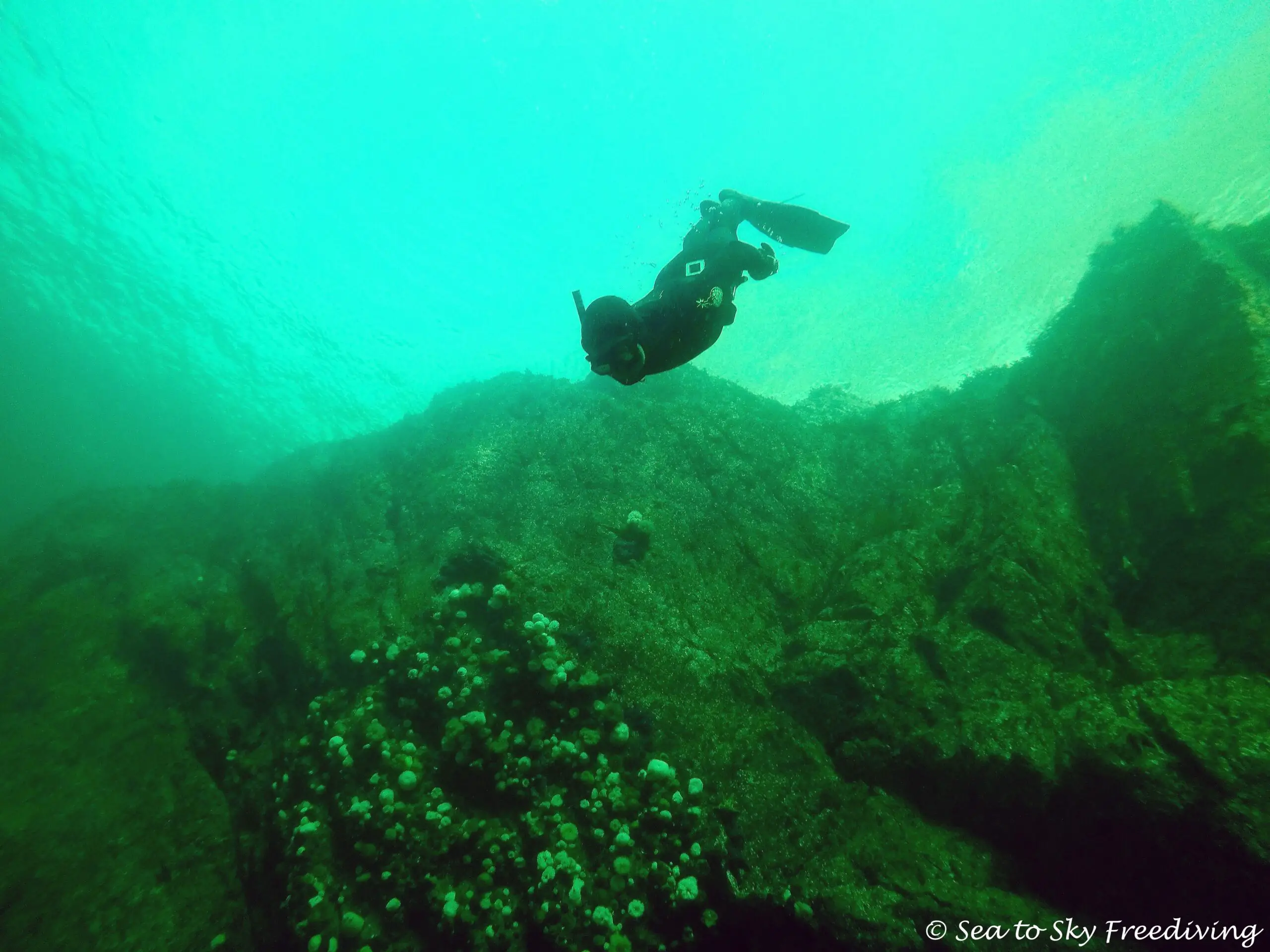

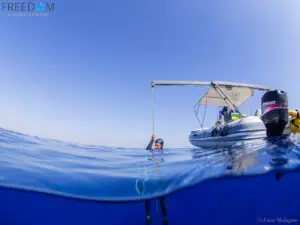
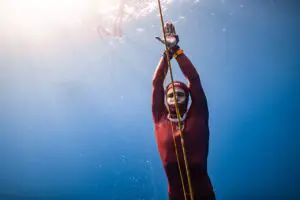
Good article, Luca. Summarizes the main issues extremely well, especially the custom suit.
I would take issue with the farmer john style. I think it is better to go high waist with a smooth skin out, open cell in, sleeveless vest. That option gets away from almost all the disadvantages of the farmer john and keeps the advantages and more. The trick is finding a vest that fits. Custom is the way to go, if you can get the suit maker to do it.
Hi Connor, thanks for your feedback. I like that idea as it’s more versatile, only trouble (I’ve found at least) is finding a comfy vest that fits well. Any suggestions on the brand?
You hit the problem. I have no good suggestions; its too individual. Mine is a very old Imersion with a metalized inside, nylon out. It used to stick to me just great, no water got under it. Not anymore, so its not quite as warm as it used to be. Fits me perfect. If I had to do it again, I’d go back to Elios and see if they would make me a vest.